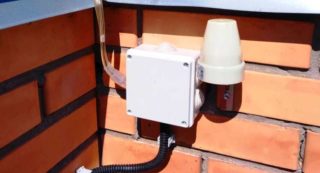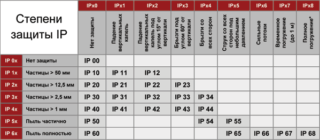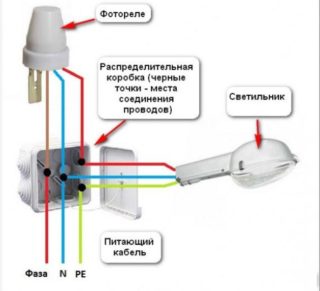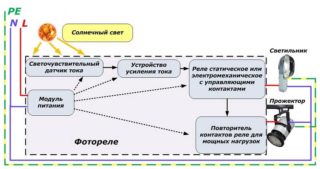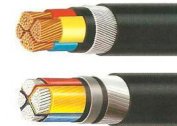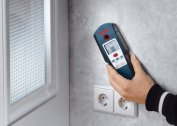Owners of country houses often want to organize autonomous lighting on their personal plot. There are two options for arrangement - installation of a light sensor or an astrotimer. The first device is considered more preferable because it has an acceptable cost and simple design with interchangeable parts.
The principle of operation and the device of the sensor day-night to turn on the light
The day-night sensor has many names, the most common among them is the photo relay. Despite the large number of items, the task remains one - to turn on and off the lighting on the street automatically.
The principle of operation of the light sensor is based on the ability of some structural elements to respond to the intensity of ambient lighting. For this purpose, photoresistors, phototransistors and photodiodes are most often used. With a decrease in lighting with the arrival of the evening, the photosensitivity of one of these details begins to change. As soon as the changes have reached the set parameters, a closing relay is activated, which ensures an uninterrupted supply of electricity. With the arrival of the morning, reverse processes occur, the contacts in the relay open and the lighting turns off.
Characteristics and selection criteria
First of all, you need to determine the type of relay used. It should be equipped with a built-in light sensor or remote. The portable is characterized by small dimensions, it is easier to protect from backlighting, the device itself is installed at home, for example, in a distribution panel. There are even din rail modifications.
A photorelay equipped with a built-in light sensor should be close to the light fixture. Also, during installation, it is important to consider that the light of the lamp can affect the photosensor, this should be avoided. A day-night sensor with an integrated element is preferable to use, for example, for lamps powered by a solar battery.
Operational characteristics
Technical parameters of possible modifications:
- Power load. Each sensor is designed to operate at a specific load power. It is recommended that the power of all lighting fixtures be approximately 20% less than the nominal. In this case, the equipment will not always be overloaded, which will favorably affect the operational life.
- Enclosure class. Devices intended for outdoor use must have a protection class of at least IP44. This indicates that dust and water particles larger than 1 mm in size will not be able to penetrate into the housing. On the street you can install devices with an even higher protection class, less is impossible. For home use, designs with IP23 protection can be purchased.
- Mode of use. If the timer for the lighting lamp will work year-round, it must be designed to work at low and high temperatures. It is recommended to take indicators with a margin in case of abnormal heat or cold.
- Supply voltage. It can be either 220V or 12V. Basically, the choice depends on the type of voltage that feeds the street lighting. 12V lighting can also be used with rechargeable batteries.
The right choice will ensure uninterrupted and productive operation of the light timer.
Customization options
There are several adjustments that will allow you to customize the operation of the sensor for a specific situation. Equipment settings at the initial stage of use are carried out manually by turning the necessary knob. It is almost impossible to achieve the same parameters.
- Adjustable light range. Thanks to this parameter, the lighting is set at which the relay closes and opens the contacts. The range can range from 2 to 100 lux at full darkness, and from 20 to 80 lux at twilight.
- The response threshold allows you to reduce or increase photosensitivity. It is recommended to reduce this parameter in winter, when there is snow on the ground and sensors react to it. It is also reduced if there are brightly lit objects in the immediate vicinity.
- Delay, measured in seconds, to turn off and on. With an increase in the turn-off delay, the number of false alarms is reduced, for example, when light comes from the headlights of a car. The turn-on delay, in turn, will prevent the light from turning on when darkened by a bird’s shadow or by a cloud.
Thanks to these settings, it is possible to ensure the correct operating mode of the equipment, extend its life and save energy.
Choosing the right place to set the off timer

For uninterrupted and correct operation of the photosensor, it is required to choose the right place for its installation. The following factors are taken into account:
- The device must be exposed to sunlight. The structure should be in the open air or canopy, but not at the very top.
- Lamps, lanterns and windows should be located as far as possible, as they can cause frequent false positives.
- It is not recommended that the headlight illuminates the sensor regularly day-night.
- Do not mount the sensors too high. This will cause difficulties in the maintenance and implementation of preventive measures.
Cases when sensors are installed directly on poles are common, but this is not always practical and convenient. It is preferable to fasten to the wall of the house and conduct the power cable.
Wiring diagrams
Connecting a time relay for street lighting should not cause difficulties. At the input of the device, phase and zero are entered, from the output, the phase starts up to the load - lighting devices, zero goes from the machine or bus.
If the installation is carried out taking into account all the rules and regulations, wired connections will be made in the junction box. If you have to turn on a powerful lighting device, it is recommended to supplement the circuit with a starter (contactor). If the lamps should light up only with the arrival of a person, the automatic lighting system is additionally equipped with a sensitive motion sensor.
Most models include three wires: black or brown, red and green. When drawing up the scheme, it is important to consider the following:
- Phase must be applied to the black or brown wire.
- A red wire is needed to connect the device to the lighting fixtures.
- Connect the neutral from the power cable to the green wire.
With the correct connection of all wires, a fully working circuit will be obtained.
How to set up a timer for outdoor lighting
Light control equipment is most often installed in close proximity to the lighting devices connected to it. The connection diagram in each case is different, you need to choose in accordance with the instructions in the accompanying documentation. It is required to familiarize yourself with the work.
For installation work it is not at all necessary to have special skills. It is only important to calculate the distributed load in such a way that the lighting fixtures do not cause a network overvoltage. The day-night sensor practically does not load the electric network. However, in the distribution panel, the RCD and the sensor itself must be selected based on the total power of the connected bulbs.
Specialists have identified several simple recommendations for installing photosensitive sensors:
- If a large number of bulbs are connected, the circuit additionally needs to be equipped with a magnetic starter.
- Do not install electrical appliances near flammable materials, chemicals, or heating elements.
- Often, inexperienced people make a mistake - they install the sensor upside down, which is absolutely impossible. Rays of sunlight can fall on it, but with the advent of darkness, artificial lighting from rooms will affect.
- It is recommended that the twilight switch and the entire lighting equipment system be connected to a separate line from the electrical distribution panel with a circuit breaker.
The main condition for correct operation is that light from any lighting devices should not fall on the sensor. Otherwise, the operation will be incorrect, the number of false positives will go through the roof.
